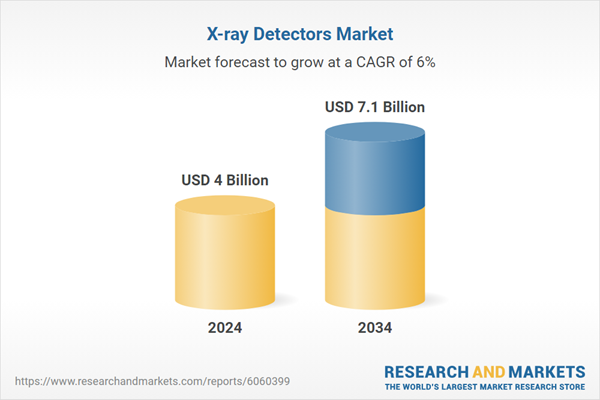Technological advancements have significantly enhanced the efficiency of X-ray detection, leading to improved image quality and faster diagnosis. The transition from film-based to digital X-ray detectors has accelerated, enabling quicker image capture and streamlined workflow in medical settings. Direct digital radiography (DR) systems, known for their speed and accuracy, are gaining traction. The market continues to evolve with the integration of lightweight and wireless detectors, offering better spatial resolution and reduced radiation exposure. Innovations in detector technology are expected to drive industry growth in the coming years.
By detector type, the market includes flat-panel detectors (FPD), computed radiography (CR) detectors, and charge-coupled device detectors, among others. In 2023, market revenue stood at USD 3.8 billion, with the FPD segment dominating, contributing USD 2 billion in 2024. FPDs are favored for their high image quality, rapid processing speed, and ability to eliminate film-based imaging, improving efficiency in healthcare facilities. Their increasing adoption in digital radiography and fluoroscopy applications is accelerating market growth. Continuous enhancements in direct conversion and wireless connectivity further strengthen their position in the industry, making them the preferred choice for medical imaging professionals.
The market is categorized into medical, dental, and other applications, with the medical segment accounting for 46.9% of revenue share in 2024. This segment is expected to generate USD 3.4 billion by 2034, driven by the increasing prevalence of musculoskeletal disorders and chronic respiratory diseases. A rise in conditions affecting bones and joints has led to greater reliance on X-ray imaging for accurate diagnosis and treatment planning. Additionally, respiratory illnesses necessitate frequent imaging, reinforcing the demand for advanced X-ray detector solutions.
Hospitals remain the leading end users, capturing a 34.5% revenue share in 2024. The high patient volume and sophisticated imaging infrastructure in hospitals contribute to their dominant market position. The integration of digital radiography systems enhances workflow efficiency, supporting the widespread adoption of X-ray detectors. Increased government investment in advanced imaging technologies further propels market growth, as hospitals continue to expand radiology departments to meet the growing demand for diagnostic imaging.
In the U.S., market revenue was USD 1.53 billion in 2023 and is projected to reach USD 6.3 billion by 2034. The rising incidence of chronic diseases and high healthcare expenditure support the extensive adoption of X-ray detectors across medical facilities. Increased awareness of early diagnosis continues to drive demand, positioning the U.S. as a key contributor to global market expansion.
Comprehensive Market Analysis and Forecast
- Industry trends, key growth drivers, challenges, future opportunities, and regulatory landscape
- Competitive landscape with Porter’s Five Forces and PESTEL analysis
- Market size, segmentation, and regional forecasts
- In-depth company profiles, business strategies, financial insights, and SWOT analysis
This product will be delivered within 2-4 business days.
Table of Contents
Companies Mentioned
The companies featured in this X-ray Detectors market report include:- Agfa-Gevaert Group
- Canon Medical Systems
- Carestream Health
- Fujifilm
- General Electric Company
- Konica Minolta
- Koninklijke Philips
- PerkinElmer
- Siemens Healthineers
- Teledyne Technologies
- Thales Group
- Toshiba
- Varex Imaging
Table Information
| Report Attribute | Details |
|---|---|
| No. of Pages | 132 |
| Published | February 2025 |
| Forecast Period | 2024 - 2034 |
| Estimated Market Value ( USD | $ 4 Billion |
| Forecasted Market Value ( USD | $ 7.1 Billion |
| Compound Annual Growth Rate | 6.0% |
| Regions Covered | Global |
| No. of Companies Mentioned | 14 |









